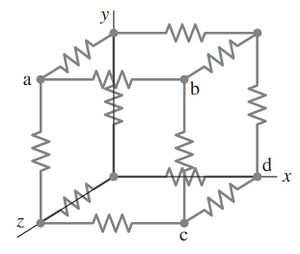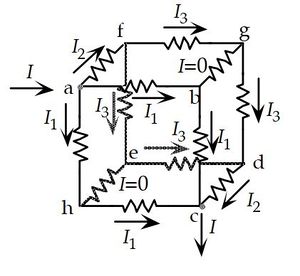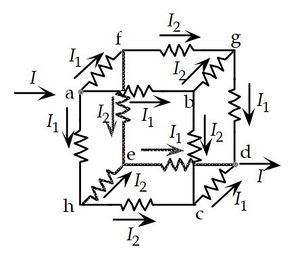Difference between revisions of "Chapter 26 Problem 40"
(→(a)) |
|||
| (6 intermediate revisions by the same user not shown) | |||
| Line 12: | Line 12: | ||
==solution== | ==solution== | ||
| + | [[File:Cube_symmetry.jpg|500px|center|Symmetries of a cube]] | ||
| + | |||
===(a)=== | ===(a)=== | ||
[[File:Chapter26problem40s.jpg|300px|center|The symmetry reduced cube]] | [[File:Chapter26problem40s.jpg|300px|center|The symmetry reduced cube]] | ||
| Line 48: | Line 50: | ||
Insert a probe battery between points (a) and (c). Let's label the current drawn from this probe battery as I | Insert a probe battery between points (a) and (c). Let's label the current drawn from this probe battery as I | ||
| + | |||
| + | This ehgb is a symmetry (inversion) plane afcd is a symmmetry plane. | ||
| + | |||
| + | #<math>I=2I_1 + I_2</math> (Junction rule at a) | ||
| + | #<math>2I_3=I_2</math> (Junction rule at d) | ||
| + | #<math>0=-2 I_2 R + \mathcal{E}</math> (loop rule around abca) | ||
| + | #<math>0=-2I_2 R -2 I_3 R + 2 I_1 R</math> (loop rule around afgdcha) | ||
| + | |||
| + | Then | ||
| + | |||
| + | <math>I_2 = \frac{\mathcal{E}}{2R}</math> | ||
| + | |||
| + | <math>I_3 = \frac{I_2}{2} = \frac{\mathcal{E}}{4R}</math> | ||
| + | |||
| + | <math> I_1 = I_2 + I_3 = \frac{\mathcal{E}}{2R} + \frac{\mathcal{E}}{4R}=\frac{3\mathcal{E}}{4R}</math> | ||
| + | |||
| + | <math>I=2I_1 + I_2=2\left(\frac{3\mathcal{E}}{4R}\right)+\frac{\mathcal{E}}{2R}=\frac {2\mathcal{E}}{R}</math> | ||
| + | |||
| + | <math>R_{\textrm{eq}}=\frac{\mathcal{E}}{I}=\frac {1}{2}R</math> | ||
===(c)=== | ===(c)=== | ||
| Line 53: | Line 74: | ||
Insert a probe battery between points (a) and (d). Let's label the current drawn from this probe battery as I | Insert a probe battery between points (a) and (d). Let's label the current drawn from this probe battery as I | ||
| + | |||
| + | #<math>I=3I_1</math> (junction rule at a) | ||
| + | #<math>I_1=2I_2</math> (junction rule at b) | ||
| + | #<math>0=-2 I_1 R-I_2 R + \mathcal{E}</math> (loop rule abgda) | ||
| + | |||
| + | <math>0=-2 I_1 R-\frac {1}{2}I_1 R + \mathcal{E} \rightarrow I_1=\frac{2\mathcal{E}}{5R}</math> | ||
| + | |||
| + | <math>I=3I_1=\frac{6\mathcal{E}}{5R}</math> | ||
| + | |||
| + | <math>R_{\textrm{eq}}=\frac{\mathcal{E}}{I}=\frac {5}{6}R</math> | ||
Latest revision as of 07:38, 1 April 2019
Problem
Twelve resistors, each of resistance R, are connected as the edges of a cube. Determine the equivalent resistance
(a) between points a and b, the ends of a side;
(b) between points a and c, the ends of a face diagonal;
(c) between points a and d, the ends of the volume diagonal.
[Hint: Apply an emf and determine currents; use symmetry at junctions.]
solution
(a)
Insert a probe battery between points (a) and (b). Let's label the current drawn from this probe battery as I
This setup has a symmetry plane between abed, so the current split at junction a will be
Another symmetry is that the afhe plane is the mirror cdgb (since one has the current I entering, and the other has the current leaving) thus we have the same currents in erverse directions in those planes.
The 6 equations in the symmetry reduced cube is:
6 equations and 6 unknowns, so we start solving:
- (2 and 6 in 1)
- (2 and 6 in 4)
- (3 in 5)
( solution of 3)
(previous into 2)
(previous into 1)
(b)
Insert a probe battery between points (a) and (c). Let's label the current drawn from this probe battery as I
This ehgb is a symmetry (inversion) plane afcd is a symmmetry plane.
- (Junction rule at a)
- (Junction rule at d)
- (loop rule around abca)
- (loop rule around afgdcha)
Then
(c)
Insert a probe battery between points (a) and (d). Let's label the current drawn from this probe battery as I
- (junction rule at a)
- (junction rule at b)
- (loop rule abgda)
































